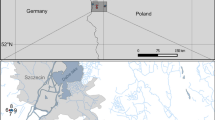Abstract
Remains of chironomids and cladocerans were studied in a profundal sediment core, which covered a time period since the Oldest Dryas. The aim was to observe long-term variability in the structure of the aquatic fauna. The most dramatic change in the chironomid fauna occurred at the end of the Younger Dryas when the predominating cold-stenothermal Sergentia coracina disappeared due to both climatic amelioration and eutrophic conditions. The chydorids showed a distinct response to the changing temperature at the end of the Oldest Dryas as evidenced by an increase in species diversity, whereas no effect was discernible in the Younger Dryas. A decrease in the proportion of ‘clear water species’ occurred in the Boreal. In the planktonic Cladocera,Bosmina longispina became extinct in the Atlantic and two Eubosmina morphs of uncertain taxonomic state very recently invaded the lake.
Similar content being viewed by others
References
Anderson, N. J., 1995. Temporal scale, phytoplankton ecology and palaeolimnology. Freshw. Biol. 34: 367–378.
Battarbee, R. W., 1999. The importance of palaeolimnology to lake restoration. Hydrobiologia 395/396: 149–159.
Bayerisches Landesamt für Wasserwirtschaft, 1992. Biologische Trophieindikation im Litoral von Seen. Inform. Ber. Bayer. Landesamt für Wasserwirtschaft 7: 1–184.
Brundin, L., 1956. Die bodenfaunistischen Seetypen und ihre Anwendung auf die Südhalbkugel. Rep. Inst. Freshw. Res. Drottningholm 37: 186–235.
Flössner, D., 1972. Kiemen-und Blattfüßer, Branchiopoda, Fischläuse, Branchiura. Tierwelt Dtl. 60: 1–499.
Frey, D. G., 1955. Längsee: a history of meromixis. Mem. Ist. ital. Idrobiol. suppl. 8: 141–164.
Frey, D. G., 1988. Littoral and offshore communities of diatoms, cladocerans and dipterous larvae, and their interpretation in paleolimnology. J. Paleolim. 1: 179–191.
Hann, B. J., B. G. Warner & W. F. Warwick, 1992. Aquatic invertebrates and climate change: a comment on Walker et al. (1991). Can. J. Fish. aquat. Sci. 49: 1274–1276.
Harmsworth, R. V., 1968. The developmental history of Blelham Tarn (England) as shown by animal microfossils, with special reference to the Cladocera. Ecol. Monogr. 38: 223–241.
Hofmann, W., 1985. Developmental history of Lobsigensee: subfossil Cladocera (Crustacea). Diss. Bot. 87: 150–153.
Hofmann, W., 1987a. Cladocera in space and time: Analysis of lake sediments. Hydrobiologia 145: 315–321.
Hofmann, W., 1987b. The late Pleistocene/Holocene and recent Bosmina (Eubosmina) fauna (Crustacea: Cladocera) of the pre-alpine Starnberger See (FRG). J. Plankton Res. 9: 381–394.
Hofmann, W., 1991. The late-glacial/holocene Bosmina (Eubosmina) fauna of Lake Constance (Untersee) (F.R.G.): traces of introgressive hybridization. Hydrobiologia 225: 81–85.
Hofmann, W., 1993a. Late-Glacial/Holocene changes of the climatic and trophic conditions in three Eifel maar lakes, as indicated by faunal remains. I. Cladocera. In Negendank, J. F. W. & B. Zolitschka (eds), Paleolimnology of European Maar Lakes. Lecture Notes in Earth Sciences. 49: 393–420.
Hofmann, W., 1993b. Late-Glacial/Holocene changes of the climatic and trophic conditions in three Eifel maar lakes, as indicated by faunal remains. II. Chironomidae (Diptera). ibid. 421–433.
Hofmann, W., 1993c. Dynamics of a littoral Cladocera assemblage under the influence of climatic and water depth changes from Alleröd to Subboreal. Verh. int. Ver. Limnol. 25: 1095–1101.
Korhola, A., 1990. Paleolimnology and hydroseral development of the Kotasuo bog, Southern Finland, with special reference to the Cladocera. Ann. Acad. Sci. Fennicae A III 155: 1–40.
Korhola, A., 1992. The Early Holocene hydrosere in a small acid hill-top basin studied using crustacean sedimentary remains. J. Paleolim. 7: 1–22.
Lieder, U., 1996. Cladocera, Bosminidae. In Schwoerbel, J. & P. Zwick (eds), Süßwasserfauna von Mitteleuropa. G.Fischer, Stuttgart, 8, 2/3, 1–80.
Lloyd, M. & R. J. Ghelardi, 1964. A table for calculating the 'equitability' component of species diversity. J. Anim. Ecol. 33: 217–225.
Lotter, A. F., 1989. Evidence of annual layering in Holocene sediments of Soppensee, Switzerland. Aquat. Sci. 51: 19–30.
Lotter, A. F., 1991. How long was the Younger Dryas? Preliminary evidence from annually laminated sediments of Soppensee (Switzerland). Hydrobiologia 214: 53–57.
Lotter, A. F., 1999. Late-glacial and Holocene vegetation history and dynamics as shown by pollen and plant macrofossil analyses in annually laminated sediments from Soppensee, central Switzerland. Veget. Hist. Archaeobot. 8: 165–184.
Lotter, A. F., 2001. The palaeolimnology of Soppensee (Central Switzerland), as evidenced by diatom, pollen, and fossilpigment analyses. J. Paleolim. 25: 65–79.
Lotter, A. & M. M. Boucherle, 1984. A Late-Glacial and Post-Glacial history of Amsoldingersee and vicinity, Switzerland. Schweiz. Z. Hydrol. 46: 192–209.
Lotter, A. F., U. Eicher, U. Siegenthaler & H. J. B. Birks, 1992. Late-glacial climatic oscillations as recorded in Swiss lake sediments. J. Quat. Sci. 7: 187–204.
Lotter, A. F., H. J. B. Birks, W. Hofmann & A. Marchetto, 1997. Modern Diatom, Cladocera, Chironomid and Chrysophyte cyst assemblages as quantitative indicators for the reconstruction of past environmental conditions in the Alps. II. Nutrients. J. Paleolim. 18: 395–420.
Lozan, J. L., 1992. Angewandte Statistik für Naturwissenschaftler. Parey, Berlin, Hamburg, 237 pp.
Nauwerck, A., 1991. The history of the genus Eubosmina in Lake Mondsee (Upper Austria). Hydrobiologia 225: 87–103.
Saether, O. A., 1979. Chironomid communities as water quality indicators. Holarct.Ecol. 2: 65–74.
Sneath, H. A. & R. R. Sokal, 1973. Numerical taxonomy. Chapman & Hall, San Francisco, 573 pp.
Walker, I. R., J. P. Smol, D. R. Engstrom & H. J. B. Birks. 1991. An assessment of Chironomidae as quantitative indicators of past climate change. Can. J. Fish. aquat. Sci. 48: 975–987.
Whiteside, M. C., 1970. Danish chydorid Cladocera: modern ecology and core studies. Ecol. Monogr. 40: 79–118.
Wiederholm, T. (ed.), 1983. Chironomidae of the Holarctic region. Keys and diagnoses. Part 1-Larvae. Ent. scand. Suppl. 19: 1–457.
Wilson, S. E., I. R. Walker, R. J. Mott & J. P. Smol, 1993. Climatic and limnological changes associated with the Younger Dryas in Atlantic Canada. Clim. Dyn. 8: 177–187.
Author information
Authors and Affiliations
Rights and permissions
About this article
Cite this article
Hofmann, W. Late-Glacial/Holocene succession of the chironomid and cladoceran fauna of the Soppensee (Central Switzerland). Journal of Paleolimnology 25, 411–420 (2001). https://doi.org/10.1023/A:1011103820283
Issue Date:
DOI: https://doi.org/10.1023/A:1011103820283




